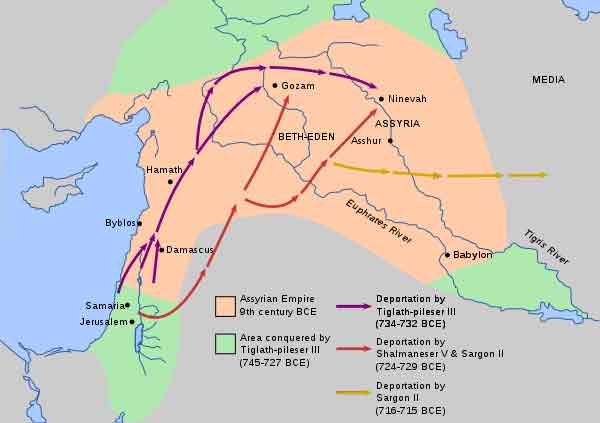
Two hundred years of political instability had thrown the ‘Kingdom of Israel’ into complete disarray. The Israelite kingdom in the north saw as many as nineteen kings during a period of just two hundred years. A few of these kings were cruel while a few were weak and had succeeded to the throne based merely on inheritance and therefore as a favour of destiny. Consequently, the Israelite masses had grown too weary and discontent among them was increasing.
Time and again the discontent erupted but was crushed with the use of military force. Times had already moved past the middle of the 8th century BC when resorting to military force on the part of the king to crush the rebellion had become an everyday affair which claimed their time and attention rather than governance and administration. Also, funds needed to meet new expenses were invariably met by burdening the commoner with taxes.
Also, during this time, gulping Babylonia along with other kingdoms in the neighbouring regions, the Assyrian Empire (Neo-Assyrian) consolidated its position in the land of Canaan. Moreover, it was already in the 732 BC that the Assyrians had invaded the Aramaean tribe and established their reign over the Armaean capital of Damascus.
So the next target of the Assyrian empire was the ‘Kingdom of Israel’, now rendered feeble by circumstances.
The Assyrian army for the past few years was already ruffling the feathers of the Israelites and had begun to gnaw at and bite off parts of their northern region. The then kings of the ‘Kingdom of Israel’ were so engaged in crushing the internal rebellions that they were not in a position to even think of facing any external aggression. Hence the Assyrian king extorted a hefty sum annually, the proceeds for which were of course collected by levying heavy taxes on the Israelites.
| Tiglath Pileser | Shalmaneser | Sargon II |
But when ‘Tiglath Pileser’, the long-time Assyrian king died, the successor to the throne rebelled against the new Assyrian ruler and refused to pay him any money. Hence, ‘Shalmaneser’, the new king of Assyria, who was as cruel as Tiglath Pileser, attacked the ‘Kingdom of Israel in the year 722 BC but died a sudden death during the battle. ‘Sargon II’, who then succeeded him, captured the whole of the ‘Kingdom of Israel’ and destroyed the capital of Samaria. The ‘Kingdom of Israel’ which was one of the two nations carved out of the original unified Israelite kingdom was completely defeated.
On conquering the kingdom of Israel, the Assyrians employed the policy that they always did with respect to the regions they captured. They were well aware that a man is bolder when in a group than when he is alone and even behaves differently in these two situations. Hence, in order to ensure that anger, vengeance, patriotism, etc., do not assume strength by way of a collective public sentiment, the Assyrians always forced the local commoners of the captured kingdoms to migrate to far-off regions and brought people of other kingdoms into theirs. They also kept the local leaders and the opinion makers away from the masses. Besides, they shifted the intellectuals to their capital city to facilitate the use of their intelligence for the Assyrian empire.
Many believe that in the times that followed, policies employed by various world powers to maintain their sway over their empires spread far and wide, ‘divide and rule’ for instance, actually find their roots in the Assyrian strategy of demographical change

The Assyrians engaged in these very tactics in case of the Israelites. After conquering the ‘Kingdom of Israel’, the Israelites who formed the majority were displaced in thousands from their native lands and were settled in various corners across the whole of the Middle East so that their contact with each other would be minimal. Many of them were once again uprooted from their native land and forcibly made to settle in lands they were strangers to. Inhabitants from other conquered kingdoms replaced them.
With this strategy, eventually the original Ten Tribes of Israel were lost from their land. It is said that they were wiped off from the pages of the history. After many centuries, some researchers initiated detailed studies in the regions where the Israelites were believed to have settled, but it did not achieve the desired results. Those who were thought to be Israelites differed vastly in their concepts, behaviour, beliefs, etc., due to generations of several local influences. Of course, there happened to be Jews who claimed to be the descendants of the ‘Ten Lost Tribes of Israel’.
As a result, after Solomon, the ten original Jewish tribes that stepped out of unified Israel and went on to form the ‘Kingdom of Israel’ are today referred to as the ‘Ten lost tribes of Israel’ and the modern-day Jews belong for the most part, to the rest of the two tribes, i.e. the Judah and the Benjamin, claim many researchers.
But many devout and staunch Jews still adhere to the firm belief that their brethren (the ‘Ten lost tribes of Israel’) will once again join them.
One of the ‘Thirteen Fundamental Principles’ of the Jewish faith states that the day will arrive when God will send a Messiah to the earth, to unite the Israelites spread far and wide across the world, which will include the ‘Ten Lost Tribes’ as well!.(To be continued…)













